The head of California’s High-Speed Rail Authority, Brian Kelly, says that the train will take longer to build and be more expensive than anyone ever thought. He almost says it like those are good things. The authority plans to publish its latest cost and construction estimates next week.
The authority recently admitted that the first section of the project, which was supposed to cost $6 billion, is now expected to cost $10.6 billion. That’s the cheapest segment of the line because it is flat Central Valley of the state. Getting from there over the mountains to Los Angeles and the San Francisco Bay Area will require expensive tunneling at both ends, including a 13.5-mile tunnel that is expected to cost anywhere from $5.6 billion to $14.4 billion.
The total cost of a truly high-speed line all the way from L.A. to San Francisco is almost certainly going to be more than $100 billion, and it won’t be complete until sometime in the 2030s at the earliest. A representative of the airline industry pointed out that, for just $2 billion and eighteen months, the state could start a high-capacity airline service between the two cities — and sell the planes if it doesn’t work out. Though rail proponents say that downtown-to-downtown train times will be comparable to flying, the Los Angeles area has five airports and Bay Area has four, so far more people live near one of those airports than to downtowns. Continue reading








